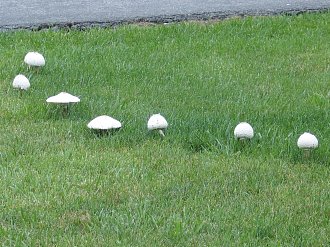Managing Mushrooms in the Lawn
Mushrooms, toadstools, puff balls... all are the fruiting structures of a diverse group of soil-borne fungi that appear in our lawns every now and then. Commonly called "fairy ring," this podcast details the practical management of this fungus that attracts so much attention when it appears.

Related Links
Our soils are loaded with many beneficial fungi that decompose organic matter on a regular basis, and the clippings that are regularly returned to lawns from mowing events can serve as a major source of carbon and other nutrients for these fungi. One of the most diverse groups of higher fungi that reside in our soils and often draw attention when they produce fruiting structures are those called ‘basidiomycota’ (formerly referred to as basidiomycetes). They produce fruiting structures that many commonly refer to as mushrooms, and yes, they are closely related to the fungi that so many of us enjoy eating (but never eat a mushroom without being completely sure it is safe—some species are highly poisonous!).
For several of these species, their fruiting bodies emerge in half or full-circle shapes in lawns in what is often referred to as a ‘fairy ring’ (a name derived from folklore). The fruiting structures take on many shapes, some having the classic toadstool shape with a ‘stem and a cap’ and others being more ‘puffball’ in appearance.
Before the fruiting structures emerge, fungal activity in the soil is often noted by dark rings or bands of turf which are actually a nitrogen-induced color and growth response of the grass due to organic matter being decomposed in the soil. The nitrogen released by the fungus is being absorbed by the turf root systems in these areas and triggering this visible response. This is often most noticeable during some kind of temperature (either warm or cold) or moisture stress period.
How should you manage mushrooms in the lawn? Rarely does fairy ring in a lawn warrant chemical treatment. It is possible that they can cause a phenomenon called localized dry spot and thinning and/or loss of turf can occur when the fungus gets so thick in the soil that water can not penetrate the fungal mass. However, this most often occurs on sand-based golf greens where it IS a major concern in this highly specialized area of turf management. Fairy ring usually does not reach this level of concern in a home lawn and if it does, one of the best treatment methods is to simply aerate the area to break through the fungal barrier.
One thing that is almost always NOT recommended or warranted for homelawns is a chemical fungicide application. These soil-borne fungi are almost impossible to control with even the most active fungicides, and the best option to deal with their fruting bodies is to simply mow them or drag them with a garden hose etc. One friend of mine does his best Bill Murray with a golf club impersonation from ‘Caddyshack’ !
The dark rings are best managed through fertilization to mask the color response; foliar applications of iron work well to hide the ring (a standard trick of the trade of professional lawn care operators that will work equally well for do-it-yourselfers), and when appropriate, N fertilizers will obviously do the job as well.


